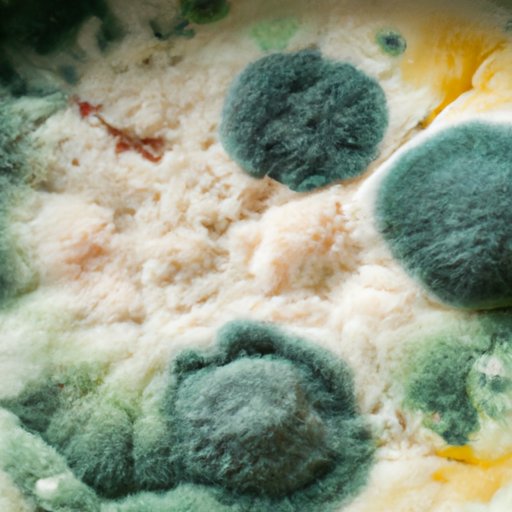
Introduction
Mold is a type of fungus that grows on various surfaces, including food. While some forms of mold are harmless, others can be dangerous and even toxic. Consuming moldy food can lead to a range of health problems, depending on the type of mold and the individual’s immune system. In this article, we’ll explore the risks and side effects of eating mold and provide advice on how to prevent the growth of mold on food.
The Dangers of Eating Mold: What Happens to Your Body
When we eat moldy food, we’re essentially consuming the spores that the mold produces. These spores can cause a range of health problems, depending on the type of mold. Some common symptoms of mold poisoning include respiratory issues, fatigue, headaches, allergic reactions, and gastrointestinal problems like diarrhea and vomiting.
In severe cases, long-term exposure to mold can lead to serious health problems like neurological disorders and even cancer. This is because some types of mold produce mycotoxins, which can be highly toxic to humans if ingested over a long period of time.
Don’t Ignore the Mold on Your Food: Health Risks of Consuming Mold
There are several types of mold that commonly grow on food, including Aspergillus, Penicillium, and Cladosporium. Each type of mold can cause different health problems when ingested.
Aspergillus can cause respiratory infections and allergic reactions, while Penicillium can produce mycotoxins that affect the liver and kidneys. Cladosporium can cause respiratory problems and skin irritation, among other issues.
It’s important to properly handle and dispose of moldy food to avoid exposure to these health risks. This means keeping food refrigerated at the appropriate temperature, checking food regularly for signs of mold, and avoiding the consumption of moldy food altogether.
Is Eating Mold Really That Dangerous? Here’s What Science Says
While there’s no consensus among health experts on the risks of eating mold, most agree that it’s best to err on the side of caution. Some people are more susceptible to the effects of mold than others, depending on their immune system and other factors like age and pre-existing health conditions.
While consuming small amounts of mold may not necessarily be harmful to most people, it’s still important to practice good food safety habits to avoid exposure to potential health risks.
From Infections to Allergies: Possible Side Effects of Eating Mold
When we consume moldy food, our bodies can react in different ways depending on the type of mold and our individual immune system. Some people may experience mild symptoms like headaches and nausea, while others can suffer from more severe reactions like allergic reactions and lung infections.
In some cases, people with pre-existing conditions like asthma or other respiratory problems may be more susceptible to the effects of mold than others. It’s important to monitor any symptoms after consuming moldy food and seek medical attention if necessary.
Toxic Mold Poisoning: What You Need to Know If You Ate Mold
While most types of mold are not toxic, there are some that can produce extremely harmful toxins when ingested. Toxic mold poisoning can lead to a range of health problems, including respiratory issues, neurological disorders, and even cancer.
If you suspect you have been exposed to toxic mold, it’s important to seek medical attention immediately. Your doctor can provide testing and treatment options to help manage any symptoms and prevent further exposure to the mold.
Mold and Food Safety: Tips to Prevent Mold Growth and Food Poisoning
The best way to avoid the risks of consuming mold is to prevent it from growing in the first place. Here are some tips to help keep your food safe:
- Store food properly at the appropriate temperature
- Check food regularly for signs of mold or spoilage
- Dispose of moldy food immediately
- Clean and sanitize surfaces regularly to prevent mold growth
- Avoid leaving food out for extended periods of time
Conclusion
Consuming moldy food can lead to a range of health problems, from mild discomfort to serious illnesses like toxic mold poisoning. It’s important to practice good food safety habits to prevent the growth of mold and avoid exposure to potential health risks. If you suspect you have been exposed to mold or are experiencing any symptoms after consuming moldy food, seek medical attention immediately.
Remember, prevention is key when it comes to mold and food safety. By following the tips outlined in this article, you can help protect yourself and your loved ones from the harmful effects of mold.




